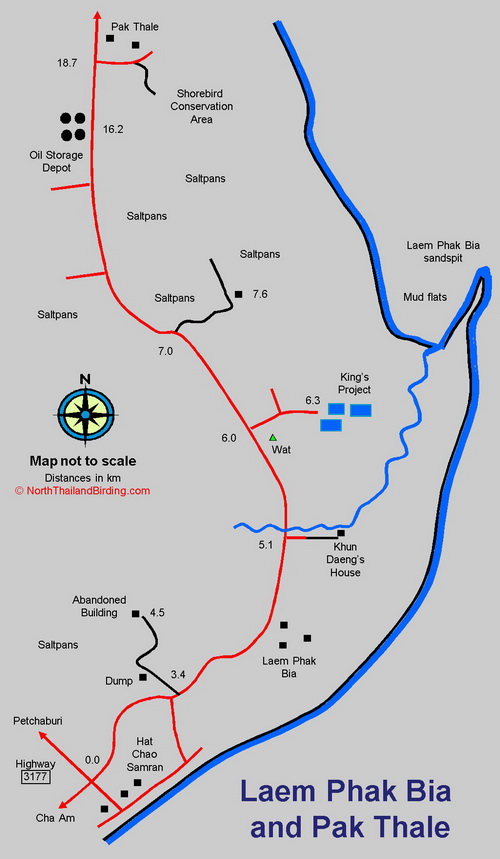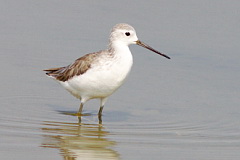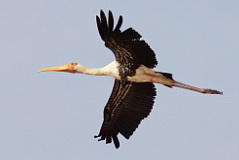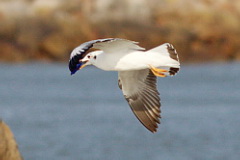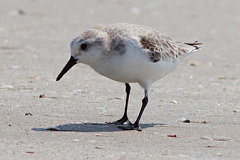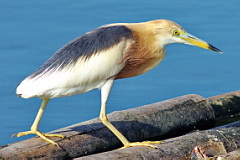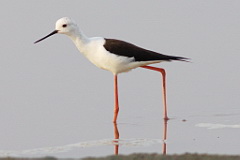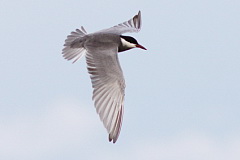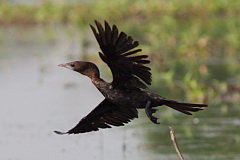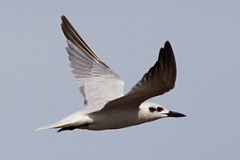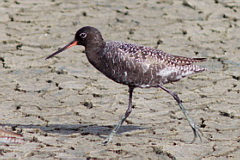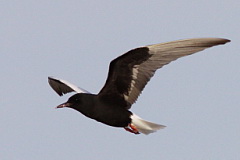Overview
This large area of salt pans on the western shore of the Inner Gulf, is rightly considered Thailand's most important shorebird wintering area. In addition to the shorebirds, the immediate surroundings support mangroves and scrub, that hold a good selection of species. Information on this page verified/accurate as of 3 Feb 2023.
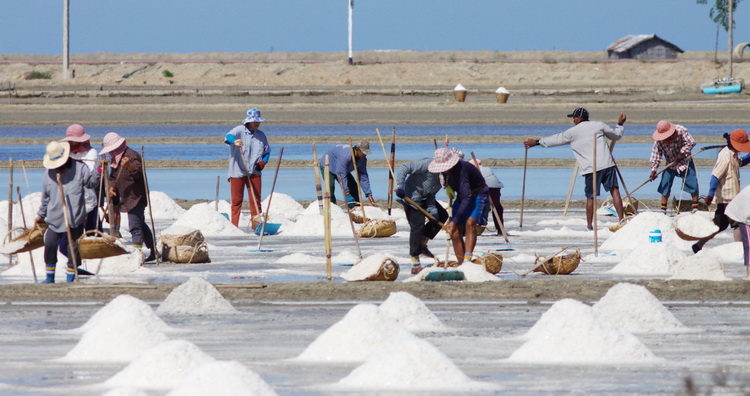
Gathering salt at Laem Phak Bia
Pak Thale and Laem Phak Bia are most famous for wintering Spoon-billed Sandpiper - a species undergoing a drastic decline. Other key species include Nordmann's Greenshank, Black-faced Spoonbill and White-faced Plover. A fair few rarities turn up - mainly on account of it being heavily watched throughout the dry season. Birding this area can be enhanced by including the scrub, fields, canals and water bodes found inland and around the Phetchaburi area, which together easily lead to a few days good birding. AccessLying about 100 kilometres south of Bangkok, it's a two to three hour drive depending on traffic. Leave Bangkok southwest on Highway 35 to connect with Highway 4, the major route south. Although there's a plethora of cross-country routes to either Ban Laem or Pak Thale it's probably simplest to head to Phetchaburi first as it's signed on all major routes. Once at Phetchaburi head into the city and pick up signs for either Hat Chao Samran or Ban Laem, which should then lead onto Highway 3177 heading straight toward the coast after about 20 kilometres from Phetchaburi. At Hat Chao Samran Highway 3177 intersects with the north-south coastal road, at the only set of traffic lights, outside Hat Chao Samran. Zero the trip meter at this intersection. Turning left, north, then leads past all the important birding spots in the area, eventually arriving at the Pak Thale Shorebird Conservation Area after 18.7 kilometres. |
Accommodation and Facilities
Being a beach resort, Hat Chao Samran has a good number of both small and large resorts to choose from. Despite this, finding a room during weekends and peak periods can be difficult so book in advance to be sure. Plenty of eating establishments are found in town and along the beach. Shops in Hat Chao Samran are limited to a convenience store and a couple of smaller general stores. For supermarkets, pharmacies and the like it's necessary to return to Phetchaburi. Given the short driving time to and from Phetchaburi, staying there can be a good alternative, especially when birding other areas around the city.
Birding
Birding can be done anywhere along, or off, the coastal road. The whole stretch from Hat Chao Samran to Pak Thale consists of a variety of salt pans, scrub, and mangrove. Stopping anywhere and scanning will reveal birds. Several paved roads inland can be explored with additional habitats which include rice fields, fresh water canals and sedge filled pools.
Abandoned Building
At 3.4 kilometres from the intersection, just after a huge sluice gate, a dirt road leads left toward what's generally referred to as the "abandoned building". This track is drivable in the dry season and leads, after a kilometre or so, to an incomplete, multi-storey building. A small rubbish dump is passed en route. Scrub in the vicinity of the dump can be worth checking and such species as White-shouldered Starling, Common Iora, Indochinese Bush Lark and Malaysian Pied Fantail which are regular.
|
Shortly after the dump the track opens out into a large area of salt pans. Over the years many waterbird species have been found here; some regular possibilities include Painted Stork, Red-necked Phalarope and Pied Avocet. |
|
Laem Phak Bia Sandspit A visit to the sandspit is very worthwhile, but dependent on the tides and high water levels. Whilst it is possible to access the coast through Laem Phak Bia village and trudge three to four kilometres up the coastline, the easiest option is to take a boat with the local boatman Khun Daeng. He's been taking birders out to the sandspit for many years now and is very knowledgeable on the shorebirds of the area. Khun Daeng's house is found by turning into the dock area immediately before the major river outlet and following the track a couple of hundred metres to the very end. The turning is 5.1 kilometres from the intersection and the river here is always lined with colourful fishing vessels, so easy to locate. His house is the last on the left. It's a good idea to go here immediately on arrival at Laem Phak Bia, to find out which time of day is possible to make the journey out to the spit, and plan the rest of the birding around that. The trip is only about 20 minutes each way, with usually 1-2 hours available on the spit for birding before the tide drops and the boat needs to return. The spit is best known as a regular wintering site for the enigmatic White-faced Plover, one or two of which usually turn up between November and March. However, they can be extremely erratic - disappearing from the spit for no apparent reason. |
|
A small number of Malaysian Plover are usually to be found, with Chinese Egret fairly regular. Sometimes at high tide Spoon-billed Sandpiper turn up. It's also a good place to look for any odd wintering gulls such as Pallas's Gull, Hueglin's Gull or Mongolian Gull. A variety of terns and waders can be found. For those in need of some local assistance for other specialities of the area such as Spoon-billed Sandpiper or Nordmann's Greenshank, Khun Daeng can guide for a nominal fee.
Environmental Research and Development Project (King's Project) Colloquially known as the King's Project, this is series of ponds plus some small areas of grass, sedge and reed, backing on to mangrove. As the area is secure and protected, the birds around the ponds are quite approachable by vehicle and make for good photographic possibilities. The project is found by turning right at 6.0 kilometres, just after the temple, and proceeding about 300 metres to the entry checkpoint on the right. Visitors are required to register names and vehicle registration details at the gate. Common species found driving around the ponds include Javan Pond Heron, Chinese Pond Heron, Red-wattled Lapwing, Pin-tailed Snipe, Little Cormorant, Little Egret and Eastern Great Egret. Less frequent birds include Indian Cormorant, Little Grebe, Greater Painted-snipe, Black-capped Kingfisher and Ruddy-breasted Crake, A couple of short walkways give access inside the mangrove, where Golden-bellied Gerygone is abundant and Little Heron can usually be found. During migration Oriental Reed Warbler is quite vocal. Ponds immediately outside the project usually hold good numbers of Brown-headed Gull, Whiskered Tern, and various waders. During 2015 and 2016 extensive building and earthworks have been undertaken, with much of the habitat being degraded. |
|
|
|
Salt Pans from Km 7 At 7.0 kilometres the road bends to the left and a drivable track heads off right into the salt pans. Depending on the time of day and position of the sun any of the pans either side of the road here are likely to hold groups of waders. Scan the pans for Great Knot which seem to favour this area and Nordmann's Greenshank often associate with them. From this point the main road heads north for another 12 kilometres, passing a vast array of salt pans, any of which can hold shorebirds or waterbirds of interest. |
Morning is the best time to work this stretch of road going north, with the sun behind. Check through flocks of gulls for any straggling Pallas's Gull. The pans either side of the oil storage depot are usually good for Painted Stork, and in recent years one or two Milky Stork have been hanging around with them. Many storks roost in the tall trees and concrete posts just to the north of the oil depot. Spot-billed Pelican is a regular wet-season visitor present from about May to September.
Pak Thale Shorebird Conservation Area Two and a half kilometres after the oil storage depot the village of Pak Thale is found. Just before the village a sign indicates a right turn to the Shorebird Conservation Area. Turn right here and proceed to skirt the village for about 600 metres after which a broad track bears right into the salt pans. This is the traditional area for Spoon-billed Sandpiper, although the large number of Red-necked Stint appear to offer a daunting task. Stick to the main tracks and avoid walking on the narrow banks between the pans here, as the workers have had to repair damage done by birders in the past and do not take kindly to people wandering everywhere. Scan through any groups of Eurasian Curlew for Far Eastern Curlew which sometimes occur. This area often has Broad-billed Sandpiper, Terek Sandpiper and Red-necked Phalarope. In some winters Black-faced Spoonbill could be in the area. Other Possibilities Working any side road away from the coastal north-south route is likely to produce interesting species, especially in the dry season. Any scrub along the road to the south of the intersection at Hat Chao Samran could hold Indian Nightjar, and rice fields and sedge-lined canals hold Asian Openbill, all three species of weaver - Baya Weaver, Streaked Weaver and Asian Golden Weaver. Indochinese Bush Lark is widespread in roadside scrub. |
|
Checklist
Checklist of species.
Gallery
Additional images from Laem Phak Bia available in the Thailand Travel gallery.
Sunrise and Sunset
Detailed sunrise and sunset times.

